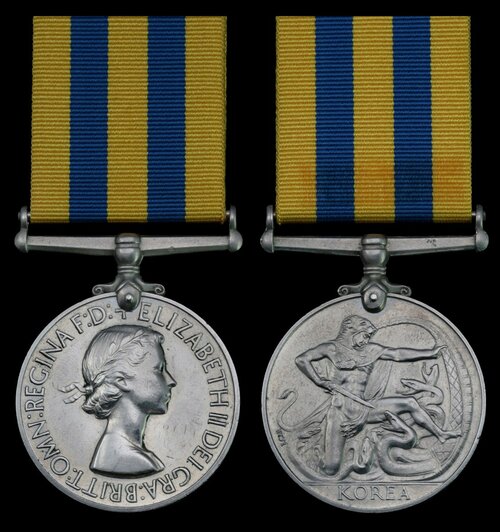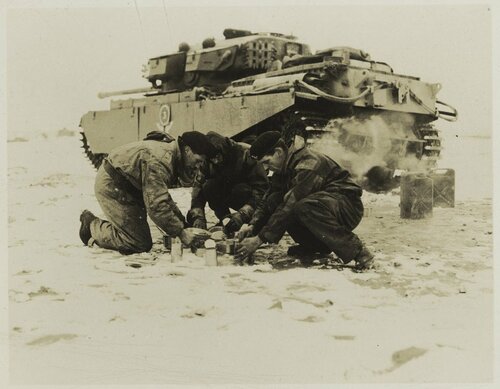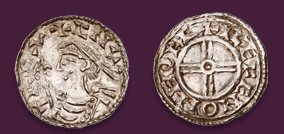Auction: 21103 - Orders, Decorations and Medals e-Auction 4
Lot: 231
Korea 1950-53 (22275161 Tpr. E. J. Ashmore, 8H.), good very fine
Served with ‘C’ Squadron 8th Hussars in Korea. That Squadron famously served at the Battle of Imjin in April 1951 under the command of Major Huth, who carried a shotgun on his tank to 'pot the enemy'.
The 8th Hussars were re-equipping with the brand-new Centurion Mk III battle tank, but still operated some ‘D-Day era’ Cromwell tanks. The Centurion incorporated lessons learned from highly effective German weapons, including Tiger and Panther heavy tanks and the famous 88mm gun. The crown jewel of the Centurion Mk III was a fully automatic stabilisation system for its main gun, combined with a new gunsight, which enabled it to consistently fire accurately while moving at speed. Experts consider the Centurion to be among the best tank designs of the early/mid-Cold War era. It was ‘On the Secret List’ in 1950/51; Royal Armoured Corps orders stressed that a Centurion must never be allowed to be captured intact.
The 8th Hussars trained intensively for eight weeks before embarking on 11 October 1950. The regiment arrived in Pusan harbour on 14 November 1950, made its way to the front line north of Pyongyang, but was soon swept up in the retreat of the UN forces in the face of vast numbers of Chinese People’s Liberation Army (P.L.A.) soldiers pushing down from the north.
In February 1951 the UN forces went onto the offensive, recapturing Seoul and pushing up towards the old border between the North and the South. The Centurions helped the Glosters to capture Hill 327. The terrain in this part of Korea was too rugged for tanks to operate effectively, and the Army felt that the 8th Hussars, having gained combat experience, could be better used in Europe. By the end of April 1951, Regimental Headquarters and two Squadrons had been pulled out of the Korea order of battle and were on their way home. Only ‘C’ Squadron was still deployed on the front line along the Imjin River when the Chinese Spring Offensive opened on the evening of 22 April 1951. The entire Chinese 63rd Army was tasked to wipe out one puny British Infantry Brigade and its handful of tanks. Swarms of Chinese troops crossed the Imjin and began to infiltrate along the gaps between the British units.
The 29th Independent British Brigade was allocated 12 miles of front, comprising steep hills intersected by deep valleys. It was impossible to form a continuous defensive line, so Brigadier Brodie decided to deploy each infantry battalions on a separate key area of high ground, relying on his artillery and tanks to cover the wide gaps between them, including the dominating 675m high feature called Kamak San. In particular, there was a wide gap between the Glosters to the west of the Brigade area and the other three battalions who were safeguarding the main north-south highway (Route 11) to the east.
On 24 April, crowds of enemy soldiers poured off the flanks of Kamak San:
'Throughout that day and the next, tanks were in perpetual demand, invoked like guardian angels, at every point of threat and crisis.’ (History of the VIII King’s Royal Irish Hussars refers).
It was not a good day for the 8th Hussars: two Centurions came under heavy, accurate mortar fire and drove off Route 11 into the paddy fields, where one stopped and the other, tilted at an angle as the driver attempted frantically to turn, built up mud around its drive wheels and threw off both of its tracks.
On the third day (25 April), thousands of Chinese infantrymen were still ferociously attacking. The exhausted men of 29th Brigade were ordered to withdraw, with the bulk moving south along Route 11, covered by the Centurions. The Glosters, who could still not be reached and helped in any way, were told to pull out across country in small groups. Once the order to retreat was received, Captain Murray resolved to recover the two immobilised Centurions, despite intense enemy activity in the vicinity. He deployed a small infantry force to provide local protection for the Armoured Recovery Vehicle. One Centurion was saved, but the enemy was pushing hard, time was passing and Murray was ordered to destroy the gun stabilisation system and gunsight of the second tank before the Chinese could overrun his position. Murray reluctantly complied, planting the demolition charges himself. He was wounded in the head and shoulder before climbing back into the turret of his Centurion and resuming command of the vehicle. It was time to leave in a hurry, as the Chinese infantry and anti-tank teams were capturing stretches of Route 11 right down the valley and ‘there was a very real danger of all the tanks being cut off irrecoverably.’ (ibid)
The Centurions covering the British withdrawal down Route 11 were forced off the road in many places. As a veteran 8th Hussar recalled years later, ‘It was more or less a death or glory sort of stunt,’ running a gauntlet of treacherous paddy fields and PLA soldiers with sticky anti-tank mines. British infantrymen, jam-packed on the backs of the tanks, were raked by small arms fire at close range; only a few survived the death ride. Two Centurions were knocked out by the sticky anti-tank mines, which Chinese soldiers had to attach to the moving tanks by hand, a close to suicidal task, as each vehicle tried to protect itself and its neighbours. One of the rear-guard Centurions was lost when it drove into a deep dyke and stuck its gun into the ground like a spike.
The final day of fighting during the Imjin River battle cost ‘C’ Squadron six of its Centurions and five other vehicles. The Chinese were not able to recover any of the Centurions that they had captured. Their Spring Offensive was irreparably damaged by the casualties that they had suffered at the hands of 29th British Brigade. The 63rd Army lost over a third of its strength and was pulled out of the Chinese Offensive. The P.L.A. failed in their bid to capture Seoul and were soon retreating again. All the United Nations troops had resisted fiercely, but the British had fought the most ferociously, held out the most tenaciously, inflicted the highest casualties and won the greatest fame.
Less than five weeks after their pullback from the Imjin River, all three Squadrons of the 8th Hussars were back on the Imjin battlefield (their rotation back to Europe had been countermanded). All the lost Centurions were recovered and repaired, except for one, a total wreck, which was cannibalised for its parts until it was only useful as scrap metal. On 19 May 1951, Brigadier Brodie of 29th Independent British Brigade approved proposals for gallantry awards to four officers and two other ranks of the 8th Hussars for the Imjin River fighting.
Subject to 20% VAT on Buyer’s Premium. For more information please view Terms and Conditions for Buyers.
Sold for
£700
Starting price
£160







